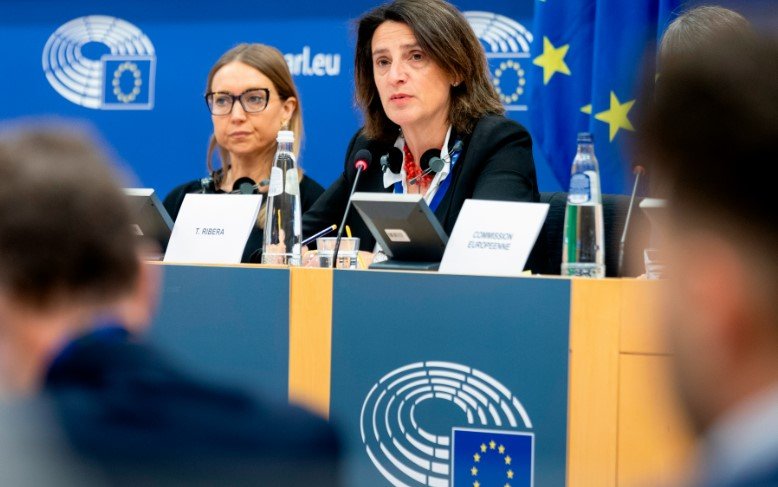Brussels backs away from talk of ‘decoupling’ as new digital strategy emphasizes cooperation — not confrontation.
Europe has spent years talking tough about building its own tech muscle. But this week, Brussels is admitting what’s been obvious to insiders for a while: it’s not ready to go it alone.
In a draft of its upcoming International Digital Strategy reviewed by POLITICO, the European Commission is poised to scrap any pretense of a quick break from U.S. Big Tech. The plan signals a shift from independence to interdependence — with the U.S., and increasingly, Asia.
So much for a Euro-tech revolution
For much of the past two years, the EU had leaned hard into “tech sovereignty” — the notion that it could build its own cloud platforms, chip industries, and AI systems free from U.S. dominance. Lawmakers framed it as a matter of economic security, especially after a string of bruising fights with Washington over data access, surveillance, and competition rules.
But with Trump back in the White House and transatlantic relations under strain, reality is setting in.
One paragraph in the draft says it plainly: “Decoupling is unrealistic and cooperation will remain significant across the technological value chain.”
That’s Brussels speak for: we still need Silicon Valley — and probably will for a long time.

Why it’s hard to quit the U.S.
Despite big ambitions, Europe’s tech ecosystem is still missing key pieces.
Just look at cloud computing. Amazon Web Services, Microsoft Azure, and Google Cloud dominate the EU market — together holding more than 70% of it. The much-hyped “sovereign cloud” initiatives like GAIA-X haven’t gained meaningful traction outside policy circles.
Chips? Europe produces less than 10% of the world’s semiconductors, and nearly all high-end fabs are in Asia or the U.S. Even with the EU’s $47 billion Chips Act, it’ll take years before any measurable change kicks in.
And AI? Most foundational models — like GPT, Claude, or Gemini — come from American labs. Europe is ahead on regulation, but that doesn’t replace having core infrastructure.
What the new strategy really says
The upcoming strategy doesn’t totally abandon the sovereignty idea, but it recasts it. Instead of going solo, Europe wants to “shape” global tech rules — preferably in collaboration with like-minded partners.
Key points in the draft include:
-
Reinforcing digital cooperation with the U.S. on standards, AI safety, and infrastructure
-
Expanding tech ties with Japan, India, South Korea, and — more controversially — China
-
Investing in resilient supply chains, but without cutting off global players
-
Encouraging European firms to compete, not isolate
One line in particular sums up the shift: “Strategic autonomy should not be misunderstood as isolation.”
That’s diplomatic code for: let’s not shoot ourselves in the foot.
Inside the Eurostack movement
All of this could frustrate the so-called “Eurostack” movement — a loose coalition of economists, policymakers, and privacy advocates pushing for a full-stack, made-in-Europe tech alternative.
They’ve gained real traction. Cristina Caffarra, a leading competition economist, and Kai Zenner, a key digital policy adviser, have become the faces of this camp. Their message? Europe’s dependence on U.S. firms puts it in a dangerous spot — economically, politically, and socially.
But critics argue their vision is idealistic, expensive, and — for now — unrealistic.
Here’s a look at the current balance of tech power in Europe’s critical sectors:
| Sector | US Dominance (%) | Notable EU Players | Notes |
|---|---|---|---|
| Cloud Computing | ~72% | OVHcloud, Deutsche Telekom | Limited EU presence, no hyperscalers |
| Semiconductors | ~85% import | ASML, STMicroelectronics | ASML leads in lithography, but fabs are lacking |
| Artificial Intelligence | ~90% | Aleph Alpha, Mistral | Promising startups, but low scale |
| Social Media | ~95% | None | No serious EU contenders |
Henna Virkkunen’s balancing act
Finland’s Henna Virkkunen was named the EU’s first-ever Commissioner for Tech Sovereignty last December. Since then, she’s tried to walk a tightrope — acknowledging Europe’s weaknesses while keeping the dream alive.
In April, she told the European Parliament: “Strategic sovereignty is not a fortress; it’s a network of trusted partnerships. We must build, not bunker.”
But some in Parliament aren’t buying it. A draft motion circulated last month criticizes the Commission for “watering down” Europe’s digital ambitions and “surrendering to market dependencies.”
There’s tension brewing — and it’s not just in Brussels boardrooms.
Trump’s return rattles Brussels
The geopolitical backdrop makes everything harder. With Trump back in power and taking a more transactional view of alliances, the EU is worried.
Already, his administration is playing hardball. There’s talk of restricting exports of AI chips. A review of the U.S.-EU Data Privacy Framework may be on the table. And industry insiders say pressure is mounting on U.S. firms to localize key operations — or risk being cut out of federal contracts.
The EU sees the writing on the wall. It can’t afford to alienate Washington, but it also can’t keep dancing to its tune.
One official, speaking off-record, put it bluntly: “We don’t have the leverage to walk away. We’re just trying to avoid being squeezed.”
What comes next?
The Commission is expected to unveil the final strategy by mid-June, with an official briefing planned shortly after the G7 digital ministers’ meeting in Turin.
Will it satisfy both sovereignty hawks and pragmatists? Probably not. But it reflects the reality Europe is dealing with.
There’s no “great decoupling” on the horizon. Instead, expect more quiet deals, cautious cooperation, and — yes — some symbolic funding for Euro-grown alternatives. Just don’t expect a tech independence day any time soon.








